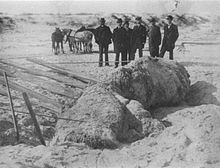| This article needs additional citations for verification. Please help improve this article by adding citations to reliable sources. Unsourced material may be challenged and removed. Find sources: "Globster" – news · newspapers · books · scholar · JSTOR (February 2017) (Learn how and when to remove this message) |

A globster or blob is an unidentified organic mass that washes up on the shoreline of an ocean or other body of water. A globster is distinguished from a normal beached carcass by being hard to identify, at least by initial untrained observers, and by creating controversy as to its identity.
History
The term "globster" was coined by Ivan T. Sanderson in 1962 to describe the Tasmanian carcass of 1960, which was said to have "no visible eyes, no defined head, and no apparent bone structure." Other sources simply use the term "blob".
Many globsters have initially been described as resembling gigantic octopuses, though they later turned out to be decayed carcasses of whales or large sharks. As with the "Chilean Blob" of 2003, many are masses of whale blubber released from decaying whale corpses. Others initially thought to be dead plesiosaurs later turned out to be the decayed carcasses of basking sharks. Others remain unexplained. Giant and colossal squid may also explain some globsters, particularly those tentatively identified as monster octopuses.
Some globsters were examined only after they had decomposed too much and seemed to represent evidence of a new species, or were destroyed—as happened with the "Cadborosaurus willsi" carcass, found in 1937. However, Canadian scientists did analyse the DNA of the Newfoundland Blob—which revealed that the tissue was from a sperm whale. In their resulting paper, the authors point out a number of superficial similarities between the Newfoundland Blob and other globsters, concluding a similar origin for those globsters is likely. Analyses of other globsters have yielded similar results.
Notable globsters


The following is a chronological list of carcasses that have been described as globsters or blobs in the literature.
- Stronsay Beast (1808)—believed to be a basking shark carcass.
- St. Augustine Monster (1896)—identified as a whale carcass.
- Trunko (1924)—not identified.
- Tasmanian Globster (1960)—identified as a whale carcass.
- New Zealand Globster (1965)—identified as a whale carcass.
- Zuiyo-maru carcass (1977)—most likely the carcass of a basking shark.
- Bermuda Blob (1988)—identified as a whale carcass.
- Nantucket Blob (1996)—identified as a whale carcass.
- Bermuda Blob 2 (1997)—identified as a whale carcass.
- Chilean Blob (2003)—identified as a whale carcass.
See also
- Drift whale, a carcass that washes up on shore
- Exploding whale
- Montauk Monster
- Panama Creature
- Zuiyo-maru carcass
References
- ^ Newton, Michael (2009). Hidden Animals: A Field Guide to Batsquatch, Chupacabra, and Other Elusive Creatures. ABC-CLIO/Greenwood. pp. 79–81. ISBN 978-0-313-35906-4.
- Bousfield, Edward L. & Leblond Paul H. (2000). Cadborosaurus: Survivor from the Deep. Heritage House Publishing.
- Carr, S.M., H.D. Marshall, K.A. Johnstone, L.M. Pynn & G.B. Stenson 2002. How to tell a sea monster: molecular discrimination of large marine animals of the North Atlantic. Biological Bulletin 202: 1–5.
- ^ Pierce, S., G. Smith, T. Maugel & E. Clark 1995. On the Giant Octopus (Octopus giganteus) and the Bermuda Blob: homage to A. E. Verrill. Biological Bulletin 188: 219–230.
- ^ Pierce, S., S. Massey, N. Curtis, G. Smith, C. Olavarría & T. Maugel 2004. Microscopic, biochemical, and molecular characteristics of the Chilean Blob and a comparison with the remains of other sea monsters: nothing but whales. Biological Bulletin 206: 125–133.
- Ellis, R. 1994. Monsters of the Sea. Robert Hale, London.
- Puig, R. 2004. A Whale of a Tale. Research Online, University of South Florida.
- "The story of the mysterious sea serpent of Stronsay". The Scotsman. 2018-01-17. Retrieved 2023-07-14.
- Jenkins, Bill (2022-01-26). "The 'Stronsay Beast': testimony, evidence and authority in early early nineteenth-century natural history". Notes and Records: The Royal Society Journal of the History of Science. doi:10.1098/rsnr.2021.0050. hdl:10023/25106. ISSN 0035-9149.
- "12 unidentified creatures that washed up on beaches around the world". news.com.au. 2016-01-31. Retrieved 2023-07-14.
- Anderson, Brian (2011-11-16). "Globsters: Mysterious Organic Blobs". Vice. Retrieved 2023-07-14.
- "'Whale' of a mystery is solved". Auckland Star. 24 March 1965. p. 1.